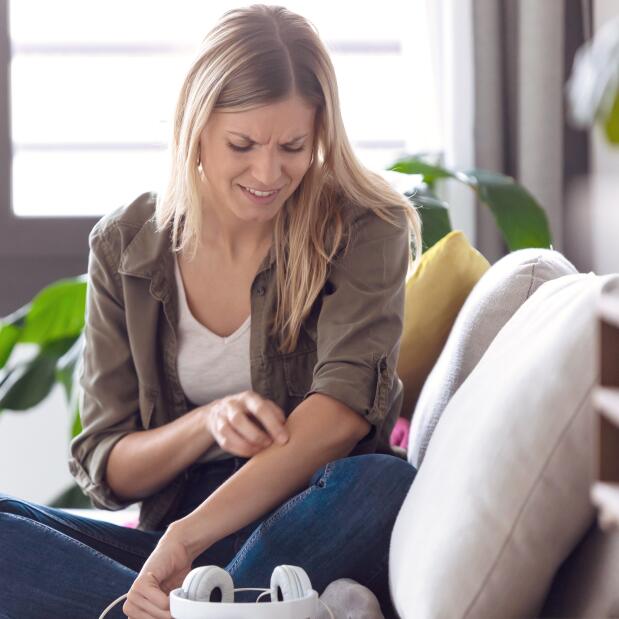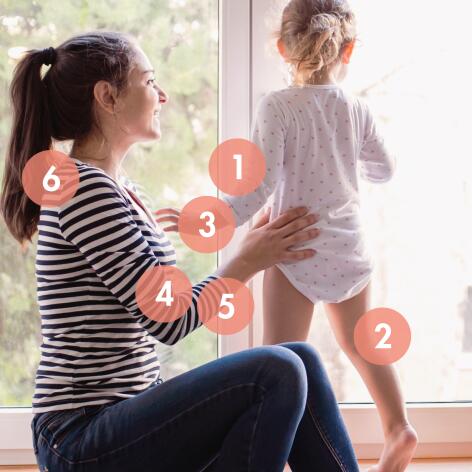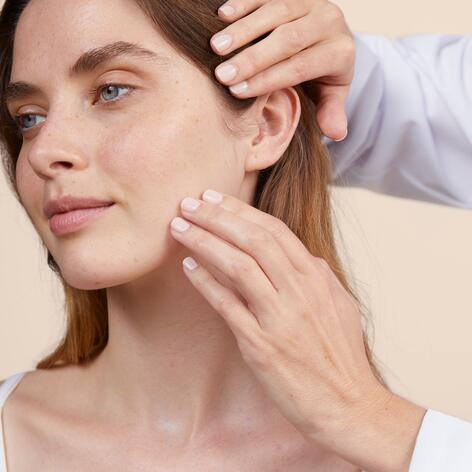Eczema of the legs and arms
- Living with eczema and psoriasis
- Psoriasis and eczema for children - rules for moisturizing
- Psoriasis and eczema in adults: suitable hygiene
- Children - Care and anti-itching tips
- Psoriasis and adult eczema - rules for moisturizing
- Psoriasis and eczema in children: suitable hygiene
- Living with eczema and psoriasis: Children
- Adults - Care and anti-itching tips
- Living with eczema and psoriasis: Adult
Eczema of the legs and arms
Eczema causes areas of the skin to become inflamed, red, swollen and to sometimes ooze, all on top of dry skin. The legs and arms are very sensitive areas, especially the back of the knees, the crook of the elbows and the wrists. Let's take a look at these areas of your body to pamper.

Your body parts are sensitive
The dryness of the skin associated with the lesions (redness, blisters, oozing, scabs) does not only affect the face. Why the arms and legs? Because eczema develops easily on parts of the body whose surface often comes into contact with cold, water or irritating products. It occurs in the crooks of the knees and elbows, two areas of regular friction where perspiration contributes to pruritus (itching).
Atopic eczema
Applying moisturiser to your legs and arms is the key gentle step that will soothe your skin and itching
Eczema will localise on different parts of the arm, depending on your age:
- In children (from 2 years of age) and adolescents, the typical form of arm eczema mostly affects the crooks of the elbows and the wrists. Make sure that your little ones’ hands are occupied. This will limit the urge to scratch.
- In adults, the crook of the elbow, the outside of the arm and the shoulders are areas affected by eczema. On the wrist, it is best not to wear a bracelet or watch that is too tight to avoid rubbing against the sensitive skin.
 CHILDREN1: Crook of the elbow 2: Back of the knee 3: Wrists ADULTS 4: Crook of the elbow 5: Outer arm 6: Shoulder
CHILDREN1: Crook of the elbow 2: Back of the knee 3: Wrists ADULTS 4: Crook of the elbow 5: Outer arm 6: Shoulder
Your leg eczema
Learn more about leg eczema and how to fight it:
Leg eczema
can result in a phenomenon called prurigo. This is the formation of red lesions with small blisters that itch very badly.
In leg eczema,
behind the knee for example, the skin will thicken and become rough and whitish. Some adults have so-called varicose eczema. This is caused by poor blood circulation.
FRIENDLY (AND EXPERT) ADVICE
Leg and arm eczema in toddlers
But what about eczema on the legs and arms of infants up to the age of 2?
Atopic eczema affects 10% of children before the age of 2. This inflammatory disease often develops on bulging areas, such as the cheeks, buttocks, calves and forearms (outer side). The flexion folds are also affected—good to know once your child is crawling and taking their first steps. Emollients should therefore be gently applied to all parts of the body, even the smallest crevices. On a daily basis, use products without soap or fragrance for baby's bath, emollients (XeraCalm AD) and restorative creams with a copper or zinc base (Avène Cicalfate Restorative Protective Cream).

Soothing eczema on the legs and arms is possible!
To counteract the alteration of the skin barrier that causes dryness and the increased sensitivity of the skin to external aggressions, there is one key word that applies to all ages: hydration!
- To avoid maceration, opt for thermal water sprays and creams, as application will be easier in the folds.
- Outside of flare-ups, apply an emollient daily to prevent and reduce scratching and dryness of the skin.
Our solutions to care for your eczema
Eau Thermale Avène skin care products designed to soothe your arms and legs
- XeraCalm A.D Ultra-rich cleansing bar
XeraCalm
XeraCalm A.D Ultra-rich cleansing barNourishes - Soothes - Cleanses - Avène Thermal Spring Water Spray
Thermal Spring Water
Avène Thermal Spring Water SpraySoothes - Restores the skin barrier - Calms - XERACALM A.D Lipid-replenishing cream
XeraCalm
XERACALM A.D Lipid-replenishing creamNourishes - Soothes - Hydrates - Soothes itchiness* - XeraCalm A.D Lipid-replenishing balm
XeraCalm
XeraCalm A.D Lipid-replenishing balmNourishes - Soothes - Hydrates - XeraCalm A.D Soothing concentrateBest Seller
XeraCalm
XeraCalm A.D Soothing concentrateNourishes - Soothes - Restores - Repairs
Which skin care routine should you adopt?
Identify what it really needs with the help of our experts and discover the most suitable skin care routine for you.





